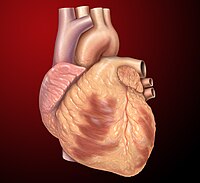
Photo from wikipedia
Objective To compare the performance of a newly developed deep learning (DL) framework for automatic detection of regional wall motion abnormalities (RWMAs) for patients presenting with the suspicion of myocardial… Click to show full abstract
Objective To compare the performance of a newly developed deep learning (DL) framework for automatic detection of regional wall motion abnormalities (RWMAs) for patients presenting with the suspicion of myocardial infarction from echocardiograms obtained with portable bedside equipment versus standard equipment. Background Bedside echocardiography is increasingly used by emergency department setting for rapid triage of patients presenting with chest pain. However, compared to images obtained with standard equipment, lower image quality from bedside equipment can lead to improper diagnosis. To overcome these limitations, we developed an automatic workflow to process echocardiograms, including view selection, segmentation, detection of RWMAs and quantification of cardiac function that was trained and validated on image obtained from bedside and standard equipment. Methods We collected 4,142 examinations from one hospital as training and internal testing dataset and 2,811 examinations from other hospital as the external test dataset. For data pre-processing, we adopted DL model to automatically recognize three apical views and segment the left ventricle. Detection of RWMAs was achieved with 3D convolutional neural networks (CNN). Finally, DL model automatically measured the size of cardiac chambers and left ventricular ejection fraction. Results The view selection model identified the three apical views with an average accuracy of 96%. The segmentation model provided good agreement with manual segmentation, achieving an average Dice of 0.89. In the internal test dataset, the model detected RWMAs with AUC of 0.91 and 0.88 respectively for standard and bedside ultrasound. In the external test dataset, the AUC were 0.90 and 0.85. The automatic cardiac function measurements agreed with echocardiographic report values (e. g., mean bias is 4% for left ventricular ejection fraction). Conclusion We present a fully automated echocardiography pipeline applicable to both standard and bedside ultrasound with various functions, including view selection, quality control, segmentation, detection of the region of wall motion abnormalities and quantification of cardiac function.
Journal Title: Frontiers in Cardiovascular Medicine
Year Published: 2022
Link to full text (if available)
Share on Social Media: Sign Up to like & get
recommendations!